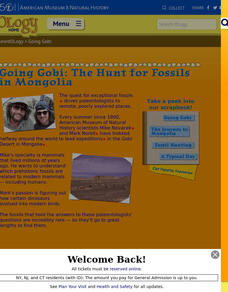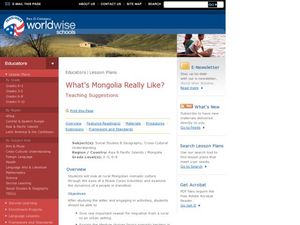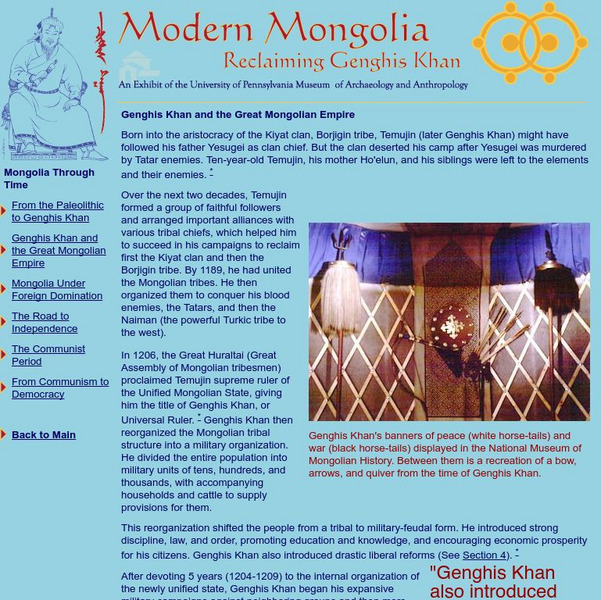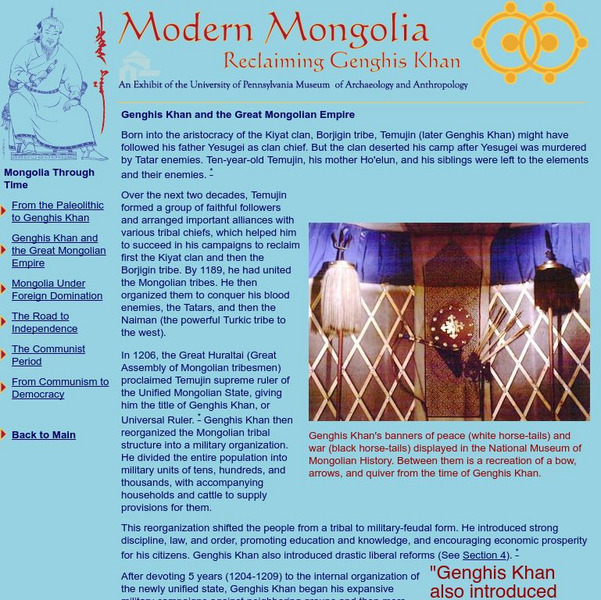Global Oneness Project
Exploring Cultural Sustainability
Small groups learn about a present-day nomadic culture in Mongolia and the threats to its existence by exploring a photo essay. The resource includes thoughtful discussion and writing prompts about cultural sustainability, the...
University of California
The Mongol Empire
Scholars review eight sources to learn about the impact of the Mongol Empire and their leaders, such as Genghis Khan. Academics learn how the Mongols destroyed states but also increased connections with the rest of the world. To finish,...
American Museum of Natural History
Going Gobi: The Hunt for Fossils in Mongolia
Take a trip on a fossil hunt. Pupils read about a trip to the Gobi Desert by a group of paleontologists to find fossils. Learners view pictures taken on the trip and determine what the scientists go through in the search for answers to...
TED-Ed
A Day in the Life of a Mongolian Queen
A four-part lesson features a video that details the life of a Mongolian queen. An eight-question quiz, related resources, and discussion questions follow the video to enhance the learning experience.
ReadWriteThink
Compare and Contrast
Read about the ways that different cultures set up homes with a set of reading activities. Learners read short paragraphs that cover one or more different ideas, and answer four questions about what they have read, including whether or...
Curated OER
What's Mongolia Really Like?
Students discover the people of Mongolia. In this social studies lesson plan, students look at the Mongolian nomadic culture by reading a letter written by a member of the Peace Corps. They describe the different types of communities...
Curated OER
Mongolian Herders' Homes Lesson Plan
Students investigate the lives and homes of Mongolian nomadic herders. They determine how the climate, available building supplies, and cultural traditions influence how the homes are built. Using art supplies, they make a replica of a...
Curated OER
Respect for Authority
High schoolers develop cross-cultural understanding. In this democracy lesson, students discuss core democratic values as they examine the governance in their school and their local community. High schoolers also discuss the...
Curated OER
Just Like the Old Days
Students examine customs of rural Mongolia. They read and discuss a letter, discuss families, locate Mongolia on a map, reenact scenes from the letter, and write a prediction of how life change in rural Mongolia during the next 50 years.
Curated OER
Respect for Authority
Students examine the country of Mongolia and how it is trying to form a democracy. As a class, they participate in a class meeting about a new class rule and they voice their opinions. They read excerpts of a letter of a Peace Corps...
Curated OER
Mongolian Museum
Students act as curator of a Mongolian museum and create a brochure detailing a new exhibit of artifacts. The brochure include a floor plan of the exhibit and a description that be used in the museum tour.
Curated OER
Just Like The Old Days
Pupils listen to their teacher read them a story about families. Individually, they make a family chart which shows everyone in their family. They read a letter about a family in Mongolia and compare it with their own. Using the letter,...
Curated OER
What's Mongolia Really Like?
Learners look at rural Mongolian nomadic culture through the eyes of a Peace Corps Volunteer and examine the dynamics of a people in transition. They give one important reason for migration from a rural to an urban setting and explain...
Curated OER
Mongolia Geography
Students examine the geography and culture of Mongolia. Individually, they cut out cut-outs of animals to place on their maps and label the grasslands and desert areas. They locate major cities and rivers along with vegetation.
Curated OER
Mongolia: Land, History and Culture
Students examine the land, culture and history of Mongolia. In groups, they use the internet to determine what groups held power and during what time periods. They also identify the most important parts of their culture and why they...
Curated OER
The Museum as a Time Capsule: Mongolian Example
Students make defensible inferences based on observation of perceived evidence. They use observation and inference to recognize the validity of alternative approaches or solutions.
University of Illinois
University of Illinois Urbana Champaign: Asian Educational Media Service
A tremendous resource for finding sites, multimedia, and other resources for teaching about or studying Asian countries. Search by country, media type, or grade level. Includes lesson plans and links to great online resources.
Association of Religion Data Archives
Association of Religion Data Archives: National Profiles: Mongolia
Learn about religion in Mongolia, in this Association of Religion Data Archives country profile; includes general facts, history, and religious data.
Penn Museum
Penn Museum: Modern Mongolia: Reclaiming Genghis Khan
Mongolia, its history, culture, and modern economy are all covered in this online exhibit.
Penn Museum
Penn Museum: Modern Mongolia: Reclaiming Genghis Khan
Mongolia, its history, culture, and modern economy are all covered in this online exhibit.
Other
Homelands Productions: The Reindeer People
A beautiful site that explores the lives of the Tsaschin, reindeer herders of the taiga of northern Mongolia. Site explores the problems that threaten the reindeer population and thus the lives of the people.
Other
Asia Society: Policy
A comprehensive storehouse of all types of information on Asia, both current and past: maps and statistics, Asian food, travel guides, photographs, articles, timelines, and more. Asia Source is the work of the Asia Society, a national...
World Health Organization
World Health Organization: Mongolia
Learn about core health indicators in Mongolia in this World Health Organization country profile, which includes demographic and current health information.
Lincoln Park Zoo
Lincoln Park Zoo: Bactrian Camel
Get the facts about the Bactrian Camel. Information includes where it lives in the wild, its niche environment, what its diet consists of, what it looks like as well as its reproduction habits.

























